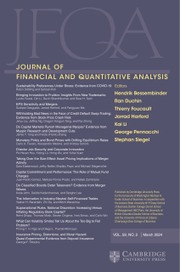Article contents
Predatory Lending and Hidden Risks
Published online by Cambridge University Press: 26 June 2025
Abstract
We study a specific practice of predatory lending: Borrowers being rejected and approved in rapid succession by the same lender. We show that in such cases borrower and contract characteristics and ex post performance are consistent with predatory steering. Steered borrowers are associated with groups with lower financial sophistication. They are more likely to enter non-amortizing contracts with high profit margins that are quickly securitized. Steered borrowers default less in boom years when refinancing is easy. However, their performance deteriorates sharply once falling prices trap them in contracts with rising payments, reflecting the long-term costs of predatory lending.
Information
- Type
- Research Article
- Information
- Journal of Financial and Quantitative Analysis , Volume 60 , Issue 5 , August 2025 , pp. 2526 - 2554
- Creative Commons
- This is an Open Access article, distributed under the terms of the Creative Commons Attribution licence (http://creativecommons.org/licenses/by/4.0), which permits unrestricted re-use, distribution and reproduction, provided the original article is properly cited.
- Copyright
- © The Author(s), 2025. Published by Cambridge University Press on behalf of the Michael G. Foster School of Business, University of Washington
Footnotes
The views expressed in this paper are those of the authors and do not reflect those of the Federal Reserve Bank of Chicago or the Federal Reserve System, or the U.S. Treasury Department. We thank Caitlin Kearns and Mike Mei for their outstanding research assistance and Han Choi for their editorial assistance. We also thank Viral Acharya, Gadi Barlevy, Mike Berry, Michael Greff, Jason Keller, Steve Kuehl, Elizabeth Laderman, Geng Li, Leonard Nakamura, Mitchell Petersen, Amit Seru, Greg Udell, Lena Vanterpool, Alicia Williams, and Marva Williams for constructive input. The comments of seminar participants at the University of Houston, Rice University, the University of Notre Dame, Baruch College, the Real Estate Finance & Investment Symposium at Cambridge, and the Kaufman Financial Policy Center at Loyola University Chicago are well-appreciated. All errors are those of the authors. Email: bizagarw@nus.edu.sg, gene.amromin@chi.frb.org, ben-david.1@osu.edu, douglas.evanoff@comcast.net.
References
- 1
- Cited by

